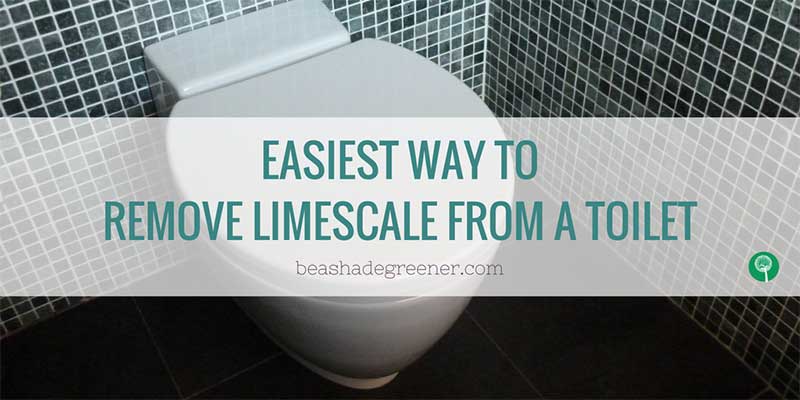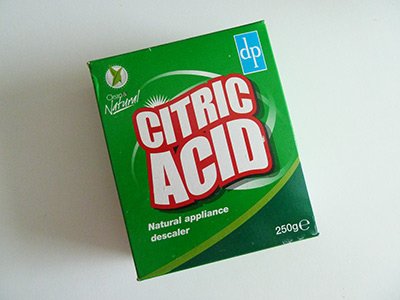Want to prevent and remove limescale in a toilet? Here are some safe, chemical-free and eco-friendly ways to prevent limescale build-up and hard water stains in your toilet bowl and cistern. I also share how to use citric acid, the best natural limescale remover in my opinon, to get rid of limescale in a toilet. Cheap, effective and no need for dangerous chemicals!

After moving into a house where the previous owner had allowed limescale to build up in the toilet bowl for years, I used citric acid to clean the toilet. (Keep reading for how to do this.) Once it was clean, I wanted to find out how I could prevent limescale from forming and the best toilet descaler and natural limescale remover.
How to prevent limescale in your toilet and limescale build up in your toilet cistern
What to put in toilet cistern to prevent limescale?
Put a chemical-free and eco-friendly Ecozone Magnoloo in the toilet cistern to prevent limescale. Pop one Magnoloo descaler into the cistern to keep your toilet free from a build-up of limescale deposits for up to five years. Use two in very hard water areas.
Review: Ecozone Magnoloo Toilet Descalers (Anti-limescale rings)
A few years ago I bought some Ecozone Magnoloo toilet descalers. The blurb claims that this “ingenious magnetic toilet descaler prevents minerals, germs and fungus from causing stains, rings and limescale build up in your toilet.” Drop one (or two if you live in an exceptionally hard water area) of these into your toilet cistern to keep your loo free from a build-up of deposits for up to 5 years. Although some reviewers say they are still using theirs 6 or 7 years on. The chemical-free magnetic ring changes the ionic charge of the calcium, stopping crystals forming and so gets rid of the problem.
Well, so far I have to say they're right! This is definitely a safe, chemical-free and eco-friendly way to stop limescale build-up in your toilet and cistern. As a limescale inhibitor it eliminates the need for chemicals which means you don't need to waste any more money on harsh limescale removal products. Plus this anti-limescale device makes cleaning the toilet much easier. Marvellous!
So, now you know best way to prevent limescale build-up in toilet cistern, but it won't remove any existing limescale though so read on for the easiest way to get rid of limescale in your toilet bowl.
Buy Ecozone Magnoloo in the UK
Buy Ecozone Magnoloo in the US
Read more posts about limescale removal
How do I get rid of limescale in my toilet naturally? How to remove limescale and brown stains
If you're too late to prevent limescale with the toilet descaler mentioned above then you'll be looking for some easy, cheap and green methods to clean limescale without the need for harsh chemicals or limescale remover products. Before you spend any more money on Calgon or more time using other descalers, here are a couple of natural limescale removers to remove thick, hard limescale build-up from a toilet bowl (or toilet pan) which have worked for me. The products I use are also used in food so there's no need to bring dangerous chemicals into your house or flush them into our waterways. You can easily get rid of limescale in your toilet naturally using products which are really cheap to buy too.
How to clean and remove limescale in toilet using citric acid

Forget coke, bleach, vinegar and toilet bowl cleaner products. In my opinion, the best thing to remove limescale is citric acid. Citric acid is the active ingredient in lemons and limes and gives amazing results when descaling a toilet and can be used instead of limescale remover tablets or blocks or toilet cistern descaler tablets.
I used citric acid to remove thick limescale build-up and it was amazing how easy it was to do. It's simply the best toilet descaler. Cheap, natural and effective. Wear gloves though as it can be harmful to your skin.
How to remove limescale from toilet below waterline with DIY homemade citric acid toilet bowl cleaner & limescale remover
Citric acid is so effective that there's no need for other ingredients when it comes to removing limescale from your toilet. This is just a simple, effective one-ingredient limescale remover and toilet bowl cleaner.
Remove limescale below the toilet waterline by pouring a citric acid solution directly into the bowl and let it sit overnight. Use a toilet brush to scrub the softened limescale. For stubborn stains, repeat treatment.
- Put on protective gloves and old clothing.
- To remove limescale from below the waterline, empty out as much water from the toilet bowl as you can by thrusting the brush several times towards the opening or scoop it out with a cup.
- Add warm water to half a cup of citric acid to make a solution.
- Pour the solution down the toilet.
- Leave for approx. 30 minutes or longer if you prefer. (I do this in the morning before I leave for work so it has the whole day to work. Or you could do it overnight, if your toilet isn't going to be used.)
- This should remove all or some of the limescale and brown stains depending on how stubborn the build-up is.
- Scrub the bowl and under the rim with a toilet brush and then flush.
- Be amazed at how clean your toilet is!
- If you need to get rid of thick limescale, you may need to repeat if limescale build-up still remains.
- Repeat once a week or as necessary to keep your toilet clean and free of limescale.
How to remove limescale from toilet cistern (or tank) using citric acid – best limescale remover for toilet cistern
If limescale builds up in your toilet cistern it can stop the flushing mechanism from working properly so here's how to clean and descale a toilet cistern.
- Put on protective gloves and old clothing.
- Remove the cover from the toilet cistern.
- Pour 1/2 cup of citric acid into a bowl or jug and add water to create a solution.
- Empty the cistern by flushing the toilet.
- Lower the water level by turning off the water supply to the toilet or adjusting the float height valve.
- Pour in your citric acid solution ensuring it covers the areas affected by limescale.
- Leave for up to 12 hours and at least 30 minutes. It works better if you can leave it longer.
- Use a brush to scrub thoroughly.
- If any limescale remains, rinse and repeat, as necessary.
Descale your toilet cistern regularly to prevent limescale from building up again. You may find once a month is enough for you but it will depend on how hard the water is in your area.
Where to buy citric acid the best limescale remover for toilets
You should be able to buy it from your local hardware shop or you can get it online:
In the UK
- Clean & Natural Citric Acid (Ethical Superstore)
- Clean & Natural Citric Acid (Big Green Smile)
- Clean & Natural Citric Acid (Natural Collection)
- Citric Acid 1 KG (Amazon)
In the US
Using vinegar to remove limescale in a toilet
You can also use white vinegar (not malt vinegar) to remove limescale in a toilet. All you need to do is empty out as much water from the toilet bowl as you can. I find thrusting the brush several times towards the opening can get rid of most of the water or you could scoop it out with a cup. Leave half a cup of vinegar in the bowl overnight and then scrub it well before flushing.
Buy white vinegar
You should be able to buy it from your local hardware shop or you can get it online:
In the UK
In the US
Using a knife to remove limescale in a toilet
If you want immediate results when trying to remove limescale in a toilet, a knife is the answer. Get an old dinner knife or buy a cheap knife, put on rubber gloves and start chipping away at the limescale. The great thing about a knife is you can use it to get rid of limescale from under the toilet rim, the bottom of the toilet or anywhere else. This method is quick and easy but I find it can scratch the toilet bowl so I don't recommend it if you don't want to mark or damage your toilet. If you're less heavy-handed than I am, you may be able to use a knife without making scratches but it's at your own risk!
I suggest using citric acid to clean your toilet and remove limescale though. It's quick and easy and I'm sure you can think of better things to do with your time than sticking your head down the toilet.
Found this post useful?
If you found the tips in this post useful, please share with your friends using the simple share buttons on this page.
Read: Bicarbonate of soda – the wonder product for your green cleaning cupboard
FAQs about toilets and preventing and removing limescale
You may also be interested in:
- How to prevent limescale in washing machine & dishwasher with Ecozone Magnoball
- Limescale in kettle: how to remove limescale from kettle
- The ideal toilet brush for the green home
- Natural ways to clean drains and to keep drains unclogged
- What can you flush down the toilet?
- Save water
Join the discussion
What are your top tips for environmentally-friendly ways to prevent limescale build-up in a toilet? How do you remove limescale in a toilet? Have you tried any of these methods?
Found this website useful?
Please consider donating a few pounds to help me develop this site. Or share this post with your friends and follow me on social media. Thanks for your support!

This is just the article I was after! I am using mangaloo’s but they don’t seem to do their magic for me. Very hard water in my area…
I’ll have arm myself with some citric acid and probably a knife too.
Nice to come across a UK green blogger 🙂 There aren’t man of us!
Hi Joanna! Thanks for posting. Please let me know how you get on with the citric acid. Hope it works for you! Yes, it’s always lovely to meet fellow UK green bloggers.
My husband is a plumber and was upset with me for putting boiled water in the toilet. It turns out really hot water /boiling water can crack the porcelain.
I was lucky, won’t be doing that again!
Citric acid works without the hot water, just leave it to soak overnight. For bad build up, need to do more than once (I did twice, worked great)
Melanie, thanks to you (and your husband!) for the tip about not using hot water. I’ve removed that from the post now. Pleased to hear that citric acid worked well for you. The results are pretty amazing!!
Another thing you can try is to put a dose of distilled vinegar in the toilet without removing the water. Leave it overnight (or as long as possible) and it will get rid of some of the scale. It is perhaps less effective than emptying the bowl first, but takes just a few seconds to do, so if you are good at remembering to do this every so often, then it does save on doing the yucky task of getting your hands dirty.
Hi Tim, thanks for the tip. Have you tried citric acid? I’ve found it to be more effective than vinegar but I do live in a very hard water area.
What quantity of water do you put with 1/2 cup of citric acid to make your solution, please?
Many thanks
Garry
Hi Garry. It doesn’t really matter how much water you add. I normally add enough water so the cup is nearly full. Sometimes I don’t empty the water out of the bowl and just pour a about a tablespoon straight in. I suggest starting off with a smaller amount and you can always do it again, if you need to. It depends on how bad your limescale problem is. Hope this works for you. Please pop back and let me know how you get on.